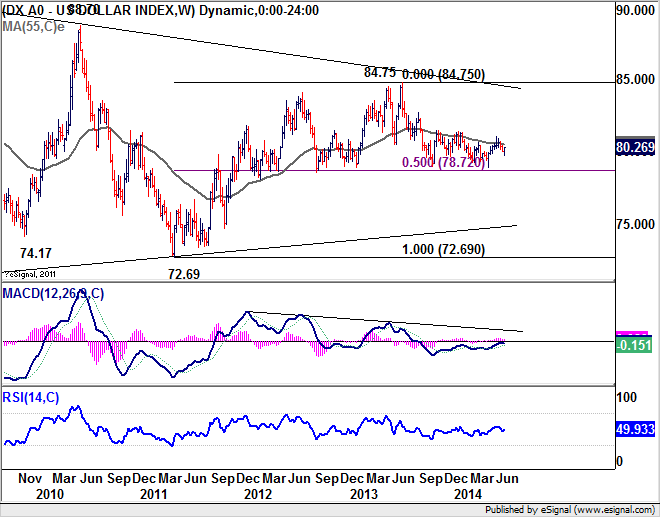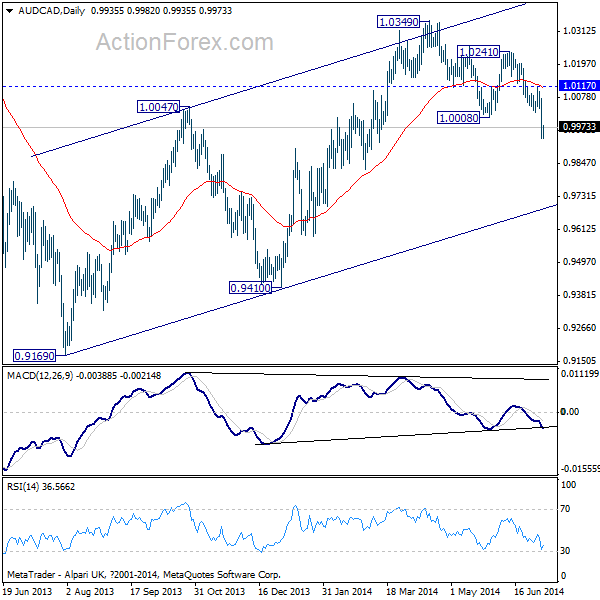In a holiday shortened first week of July, the financial markets were blessed with strong risk appetite. Dow surged through 17000 handle to close at new record high of 17068.26. The S&P 500 also jumped to close at historical high of 1985.44. Sentiments towards the US economic outlook was lifted by a string of solid economic data released over the week, in particular the non-farm payroll report. The dollar staged an impressive reversal with dollar index at 80.27 after initial dip to 79.74. Nonetheless, dollar's strength was over-shadowed by Sterling and Canadian dollar, which were the strongest and second strongest major currencies last week. Australian dollar and yen were the weakest.
To recap some of the major events, ISM manufacturing dropped slightly to 55.3 versus expectation of rise to 55.5. ISM services dropped slightly more than expected to 56.0. While both were below consensus, they were, nonetheless, solidly above 50. The non-farm payroll report showed 288k growth in June comparing to expectation of 210k. That's the second best reading since January 2012 and compares to April's 304k. Prior months's figure was revised up from 217k to 224k. The total number for Q2 was an impressive 816k. Unemployment dropped to 6.1% comparing to expectation of 6.3%. That's the lowest number in nearly six years.
The July ECB meeting mainly focused on the technical details of the easing measures it announced in the previous month and provided no surprise to the markets. ECB announced that it would reduce the frequency of its meetings to once every 6 weeks from January 2015 onward and it would publish regular accounts of the policy meetings. Eurozone CPI was unchanged at 0.5% yoy in June versus expectation of a rise to 0.6% yo
UK PMI manufacturing unexpectedly rose to 57.5 in June versus consensus of a fall to 56.7. That's the second highest level in over three years. PMI construction surged to 62.6 in June, much better than expectation of fall to 59.7. The reading was also at a four month high. PMI services missed expectation and dropped to 57.7. The solid readings suggested that UK economy had a strong Q2.
The quarterly Tankan survey showed then sentiments among Japanese firms fell in Q2. Large manufacturer index dropped from 17 to 12 in Q2, below expectation of 16. Medium manufacturing index dropped from 12 to 8 while small manufacturer index dropped from 4 to 1. Non-manufacturing index dropped to 19, inline with consensus. Medium non-manufacturing index dropped from 17 to 10 and small non-manufacturing index dropped from 8 to 2. All large industries index dropped from 21 to 16, medium dropped from 14 to 9 and small dropped from 7 to 2. All indices were even worse than, or at par, at Q4 2013 readings. But overall, it's noted by economists that the sales tax hike in April caused distortions in demand and production. And, modest rebound should be seen in Q3.
The RBA left the cash unchanged a 2.5% for a 10th month in June. Against the backdrop of a decline in consumer confidence since the release of the Federal Budget and sluggishness of the retail sector, Governor Glenn Steven indicated that it would be prudent to leave the monetary policy as it is for an extended period of time. We expect the central bank to stand on the sideline for the rest of the year and in 1Q15. More in RBA On Hold Until 1Q15 . Retail sales dropped -0.5% mom in May versus expectation of 0.3% mom.
Technically, while the Dollar Index staged a strong rebound towards the end of the week, it's still limited below 55 weeks EMA. There is no confirmation of underlying momentum in dollar and the dollar index is possibly just staying inside choppy sideway trading above 78.72 key long term fibonacci support and below 81.48 medium term resistance. Against other major currencies, dollar extended recent down trend against Sterling and Canadian dollar. The rebound against euro, swiss franc, yen and Australian dollar negated near term bearishness. So the greenback could stay mixed in near term.

Similar picture was seen in euro. The EUR/GBP and EUR/CAD extended recent down trend. However, the EUR/USD and EUR/JPY lacked a clear direction. Recovery in the EUR/AUD argued that it might be reversing. Outlook of the common currency was rather mixed. Yen was clearly not the focus of the markets. Sterling was strong, in particular against euro and yen. The GBP/AUD also took out near term resistance of 1.8332. But, the GBP/USD showed loss of momentum even though it resumed the medium term rally. Canadian dollar extended its broad based rally but started to lose momentum against dollar.
One important development to note was the selloff in the AUD/CAD last week. The cross took out 1.0080 support and reached as low as 0.9935 so far. We've mentioned before the the medium term rebound from 0.9169 could have completed with three waves up to 1.0349 already. Whether that's correct or not, the fall from 1.0349 would likely extend lower to lower channel support (now at 0.9685). We'll stay bearish in AUD/CAD as long as 1.0117 resistance holds.

Regarding trading strategies, the EUR/GBP finally broke out of range last week and our short trade is in positive territory now. Sterling's general strength is expected to extend for a while and so we'll stay short in the cross first. the EUR/CAD also extended recent decline as Canadian dollar continued the bull run. However, Canadian dollar's momentum is looking a bit stretched. And, we'd prefer to get out of one of the euro short position. So we'd close the EUR/CAD short first. Instead, we'll turn to short AUD/CAD so case to capture the reversal in Aussie while maintaining a hand on Canadian should it continues its rally. So in short, we'll stay short in EUR/GBP, get out of EUR/CAD short and turn to AUD/CAD short this week.
